Abstract
The purpose of the article is to study specific features of foreign languages distance learning and give recommendations for practical application. The author studies main psychological and pedagogical problems of distance learning, among which are minimal opportunities for contact work with students, as well as different students’ preferences when working with educational materials. The methods proposed for solving problems are 10 methodological principles of Task-Based Language Teaching, mixed reality platforms, organizing academic and non-academic support, involving students in research activities in the language being studied, video-conferencing and others. Despite the abundance of technical tools and practical methods for implementing distance education, in practice, you can face organizational, technical and methodological difficulties. To assess the critical situation with foreign languages distance learning, a survey was conducted among students who study Russian as a foreign language, particularly those from China and Taiwan. They evaluated remote classes in the form of a video conference. The results show main ways to overcome organizational and methodological difficulties. For example, it is necessary to provide recordings of classes in the form of video conferences with possibility of transcripts, prepare basic and additional educational materials in electronic form, alternate activities (listening, speaking, writing, reading), use technical facilities of distance learning platform to encourage oral speech (separate channels, recording device). As the preferred control form of the acquired knowledge, students most often chose testing. The students’ answers provide material for further clarifying research and allow to determine basic principles of distance learning methods in foreign languages.
Keywords: Distance learningforeign languagevideo conference
Introduction
This article presents an analysis of distance education possibilities for FLT purposes in the context of a dialogue of cultures in higher education institutions. It also describes tools and conclusions on the problems of distance foreign language acquisition.
The relevance of the study depends on need for a sharp transition to the mass use of distance learning in Russia in March-April 2020 in connection with the coronavirus pandemic. Naturally, the question arose about variability of such training and students’ attitude to it.
The study was conducted in the form of a questionnaire. The respondents are native Chinese students; students of the Russian language Institute, for whom Russian was a foreign language. The research conclusions of the article will help an FL teacher determine pedagogical approaches and select appropriate teaching tools for linguistic competencies formation, taking into account students’ capabilities and needs.
Problem Statement
The ubiquity of computer and Internet technologies has made language education available. It allowed students to be located in different countries and speak different languages, but at the same time they can learn a certain language taking distance courses, for example, at a University.
Russia follows global trends, so various forms of FL distance learning are also common here: for example, mass educational courses for a wide range of students, University distance courses developed to meet certain educational needs of students in accordance with approved curricula.
Events related to the spread of coronavirus infection in Russia in the spring of 2020, spurred a sharp and total transition of University education to a distance learning platform. Despite sufficient experience in this area, it has become objectively clear that both teachers and students are not ready for such significant changes.
Offline classes, which have prevailed so far in universities, are conducted by a different method than online classes. The situation is also complicated by the fact that many international students who study a foreign language (for example, Russian) live in other countries, their places of residence, which means different time zones. In the educational process, this is manifested in an inconvenient schedule, reduced communication quality, etc.
All of these factors have led to the search for short-time methods that help quickly analyze advantages and disadvantages of FL distance learning (for example, Russian) and adapt offline teaching methodology to remote methods of teaching this academic discipline at University.
The practical use of such research is to identify pedagogical tools that make it easier for students to learn a foreign language and promote interest in this academic subject.
This article does not allow us to fully cover all aspects of FL distance learning that exist in different countries. However, we can outline the main trends in distance education linguodidactics, which will undoubtedly be useful to study to determine the approach in the pedagogical process.
Research Questions
When we started our research, we made the following assumptions:
1. the world teaching practice has accumulated sufficient methodological tools for FL distance learning.
2. Distance learning methods have both positive and negative aspects.
3. There is specific training depending on target language characteristics.
Analysis of world practice in the field of distance learning languages will help identify existing problems and opportunities to overcome them. Especially interesting is the experience of the last decade (2010-2020), when new technical tools were introduced into University environment.
With all positive attitude of University teachers to distance learning, it is worth noting the presence of certain difficulties in its implementation for the purposes of linguodidactics. First of all, they are related to the necessity to activate communication in the target language and provide feedback on the results of such communication.
In addition, there are learning difficulties associated with the learned language characteristics. For example, Russian grammar and orthoepic norms are difficult for Chinese students to master, because Russian and Chinese are languages of different typological origin.
Purpose of the Study
The research conducted aims at studying organizational and methodological features of distant learning in Russia and abroad as well as at forming efficient learning environment for acquiring foreign language skills during videoconferences. Achieving the goal requires deep theoretical analysis (the one of distant learning issues) along with survey (students studying Russian as a foreign language are engaged in assessing organizational and methodological potential of videoconferencing).
Research Methods
Basic terms
When starting to study the issue, it is necessary to determine the terminology. Moore et al. (2011) studied differences in understanding of the terms to follow: distance learning, distance education, e-learning, online-learning, and others. If distance learning, distance education denote common points in training organization, taking into account opportunities, place and time, then e-learning, online-learning specify principles of technical and methodological organization of this process.
In this article, we will use the term distance education, which we understand as learning outside University in accordance with the established program, schedule and map of competencies using distance technologies (Internet access, IT platform for organizing classes) and learning tools (technical: computers, laptops, tablets, smartphones; educational: educational videos, audio messages, podcasts, files with texts, presentations, links to educational resources, etc.) under teacher’s guidance who sets goals and manages students’s training, as well as acts as a scientific consultant.
Scientific basis and methodological principles
The scientific basis is use of advanced linguistic educational practices: "The сhoice of this pragmatically oriented view of educational practices is due to the fact that foreign-language education condition, which today requires to improve process effectiveness of influencing the person learning a foreign language, in order to develop ability to participate in the dialogue of cultures” (Tareva, 2015, p. 78).
The degree of mastering Russian language linguistic norms by foreign students depends on students’ activity. Without sufficient motivation to study and desire on the part of students it is difficult to deal with didactic tasks. For example, Russian as a foreign language classes, in addition to solving their special tasks, help students reveal their potential, opportunities to apply creatively and accurately the acquired knowledge. We believe that a foreign language University teacher is interested “in creating prerequisites and conditions for creative actualization of the individual” for effective learning (Uskova, 2005, p. 28).
World experience in organizing FL distance learning
Key problems of distance education
Since 1980, distance learning in the world has gone through several stages of development: from professionalization and institutional consolidation to "interactive learning, MOOCs and OERs" (Zawacki-Richter & Naidu, 2016, p. 1).
One of the key problems of distance education is “the lack of opportunity to interact one-on-one with the instructor” (Simonson et al., 2019, p. 71).
The experience of organizing support for Open and Distance Learning students, described by Simpson, can be interesting and useful to solve the problem (2002). The types of such support are academic and non-academic. They are defined and described in detail. For the purposes of this article, we are particularly interested in the tools of academic (scientific) support, although organizational aspects (non-academic support) are also important. Here is an example: academic support consists of "defining the course territory, explaining the course, formal and informal assessment, chasing student progress, developing learning skills, exploring the course, enriching the course” (Simpson, 2018, p. 64).
Another problem is preference for different ways of learning (Coggins, 1988). Some students work better with educational materials, while others are focused on interactive communication.
Practical aspects of teaching foreign languages
The experience of interactive communication in FL distance learning, based on 10 methodological principles of Task-Based Language Teaching, is described in the works of Doughty and Long (2003). Let's list these principles, first expressed by Long: “1) use of tasks; 2) learning in action; 3) methodically based learning information; 4) a rich curriculum; 5) encouraged inductive learning; 6) attention to forms of presentation; 7) established feedback; 8) development of students' mental processes; 9) promotion of collaborative forms of learning; 10) individual approach” (Doughty & Long, 2003, p. 52). The practical implementation of the 10 methodological principles is shown, in particular, by the example of involving students in research conducted in the target language country. Students and teachers communicated via webcams, audio recordings, and a video conferencing app.
There are examples of using virtual games when learning a foreign language. For example, special mixed reality platforms are used (a 3D model of a street with objects placed on it and a mirrored real image of the same street with a video demonstration), allowing students to engage in research activities (Ibanez et al., 2011).
The possibilities of videoconferencing as an alternative to face-to-face training in situations where students cannot attend classes due to territorial remoteness are studied in detail. Creating the effect of presence in a virtual classroom using voice, intonation, moving the webcam for the best view of what is happening, asking clarifying questions and provoking a dialogue of students "teachers need to be creative and innovative to involve students in the process of learning via videoconference” (Rehn et al., 2016, p. 310).
The development of virtual technologies raises the question of professional development of teachers, which “should include knowledge and competence in tele-teacher presence and especially transmedia identity management" (Sime & Themelis, 2020, p. 70).
Thus, the leading approach to FL distance learning in the world practice is based on goals and content of training using technical training tools, following psycholinguistics and linguodidactics principles.
Features of FL distance learning in Russia and intercultural learning experience
Distance education in Russia
In Russia, distance learning in the classical sense (without use of modern technical means) has a long tradition and was previously called external degree program. In order to study foreign languages, there were linguistic courses, as well as departments in institutes and universities.
Now in Russia, distance education in universities is at a sufficient level due to the practice of introducing training courses in various formats (both interactive and stationary). However, according to the author’s observations, based on the experience of organizing commercial distance education projects in 2009-2017, commercial companies that are not associated with higher education were more interested in applying the results of training after distance courses in practice. Such courses were used for practical training of applied tools (not only in foreign languages) for office employees, sales staff, IT specialists, and representatives of some other professions. Commercial companies typically used a variety of distance learning courses and used learning management systems (LMS) to effectively manage them.
In University practice, the emphasis was shifted to the scientific, theoretical, and legal justification of distance learning, which was reflected in a series of publications in 2000-2010.
FL distance learning
An urgent need for mass implementation and testing of distance learning methods, in particular, of foreign languages, arose in March-April 2020 due to the forced self-isolation of students in Russia.
There was a question of clarifying methodological principles and features of the technical organization of the process of FL distance learning. It should be noted that by now in Russia there have been mass remote language courses, partially open on special training platforms, using Skype, Zoom and other applications to ensure remote interaction between teacher and student (commercial forms of tutoring).
Textbooks published on distance learning method reflect pedagogical process features “at a distance”, technologies of network learning are revealed and approaches to organization of teacher – student interaction are compared. The authors of textbooks recognize the role of interactive online communication methods: "an important form of distance learning can be an Internet conference that can solve problems of improving professional competence of teachers, transferring experience in using modern tools in the educational process” (Weindorff-Sysoeva, 2018, p. 26).
Special computer programs are used with tasks, tests, videograms, pictures and animations to achieve ELT goals. Mileyko (2015), exploring the possibilities of distance learning Russian as a foreign language, notes: Russian language grammar and vocabulary can be enhanced through the use of multimedia programs. It allows you to constantly maintain interest in learning Russian as a foreign language and enhance the cognitive activity of students” (p. 25).
Blagonravova et al. (2016) point out that besides multimedia and cloud tools used in FLT, constant feedback from the teacher and the student is important, for example, “by email, both corporate and personal, in a chat or blog, by phone or Skype, as well as personal consultations” (p. 87).
Gerasimova and Makarova (2016), exploring FL distance learning and possibilities of individual technological platforms, analyze conceptual pedagogical terms for creating a course of study and guiding students' independent activities. At the same time, the researchers note that the effect of such training using the platform "depends largely on teacher’s skill involved in this process" (Gerasimova & Makarova, 2016, p. 92).
In the Russian practice of teaching foreign languages, taking into account intercultural communications context, the idea of a dialogue of cultures is generally recognized.
Experience in studying attitudes to distance learning in Russia
Theoretical basis of research
The attitude of foreign students to distance learning of Russian as a foreign language in Russia requires careful study. Assessment of motives and negative factors provides a tool for improving the educational process using distance technologies.
One of the ways to get the necessary information is through online surveys. Such a tool has been repeatedly used by researchers to study the possibilities of distance learning in University practice. For example, students’ attitude to some remotely taught disciplines was evaluated and it was found that there is a “request from below” for this type of training (Bondarenko & Kolmakov, 2018, p. 54).
Teachers of higher education institutions also participated in the survey and expressed different views on distance education. The research notes that "pedagogical community does not perceive distance learning unambiguously, realizing at the same time that there are not enough specialists in Russia for implementation of this type of activity” (Dmitriev et al., 2016, p. 115).
Structure and hypothesis of research
Taking into account the experience of interviewing students and teachers described above, and considering the need to obtain timely information about the attitude of foreign language students to distance learning, the survey was conducted using an online questionnaire on the Microsoft Teams platform, followed by uploading the results in MS Excel format for statistical processing.
Russian students who study Russian as a foreign language in Russia (distantly in China and Taiwan) completed an online questionnaire in Russian consisting of 9 questions with a choice of answer options (including multiple choice). The survey was conducted 2 weeks after the start of universal distance learning in Russian universities (mid-April 2020).
A total of 26 students were interviewed (2 groups of 3rd year students, 1 group of 4th year students). A solid sample of respondents was used. The number of participants in the survey allows to give preliminary assessment and formulate practical recommendations. This information will help to change the structure of a video session in a timely manner and quickly respond to difficulties related to perception of educational material and formation of speech skills. Questions were related to technical, methodological and organizational aspects of online FLT in the form of video conferences with a teacher.
It was taken into account that students might not understand some questions or not clearly formulate answers in Russian, so they were allowed to choose an answer or formulate it themselves. It was also assumed that several possible answers could be marked.
Before starting the survey, a hypothesis was formed that a remote session in the form of a video conference differs from an offline session and involves the use of:
- visualizations (video, photo, audio, smartboards);
- small texts with teacher’s interactive explanations (through commenting in chats or by typing text in real time like a transcript);
- tests to assess the acquired knowledge and mobile voice recorders to record your speech.
In addition, the lesson should be held dynamically according to a certain scheme that allows to alternate different types of activities (reading, listening, speaking, writing), and allows each participant to regularly engage in dialogues with the teacher and other students during the video conference.
The results were processed using Microsoft Excel.
Findings
Respondents by location were distributed approximately equally between Russia (35%), China (35%) and Taiwan (31%). Gender: 65 % female and 35 % male.
Attitude to distance learning and its organization
Let's look at the results of the survey. In general, it can be noted that the opinions of students on most issues are divided. However, this allowed to identify several ways to keep students' interest in video-conferencing sessions constant when they alternate.
Distribution of respondents' answers to the question "Are you always interested in distance learning?” presented on Figure
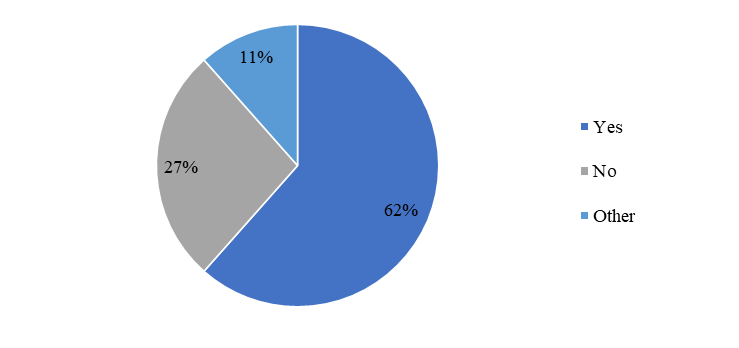
The following questions allowed to understand under what conditions remote learning is interesting, and under what conditions it is not. Among the factors that make distance learning attractive (Figure
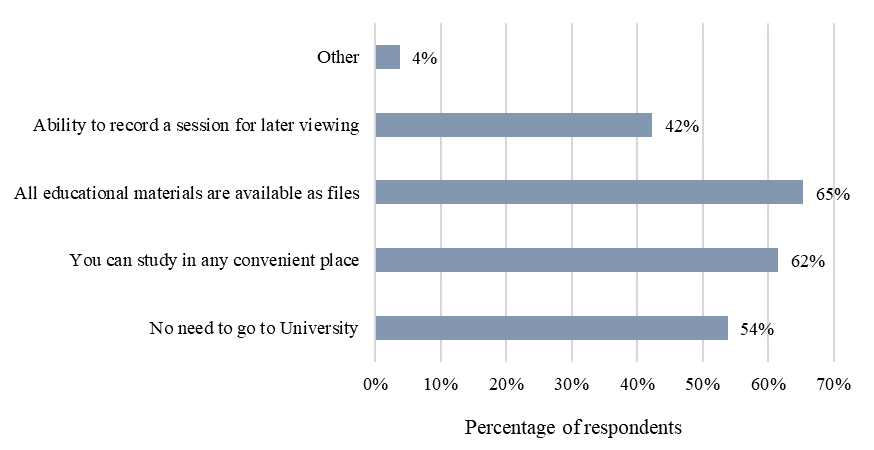
The main reasons for dissatisfaction with distance learning are poor communication quality (73%) and the schedule (35%) (Figure
Some students noted that due to poor connection, it is not possible to watch a video in real time or quickly “save” a video file. In this regard, the recording of the session and a selection of training materials (texts, videos, audio, transcripts of discussions) can be considered as an alternative to video classes in the case of force majeure.
All students, including those who were in China and Taiwan, studied according to the schedule that operated in Russia. The training did not take into account the five-hour time difference. Obviously, this caused great inconvenience to students and affected their interest in the educational process. Out of 17 people who were abroad (Taiwan, China), more than half (53%) noted inconvenience of the schedule. At the same time, none of the respondents who were in Russia chose this answer.
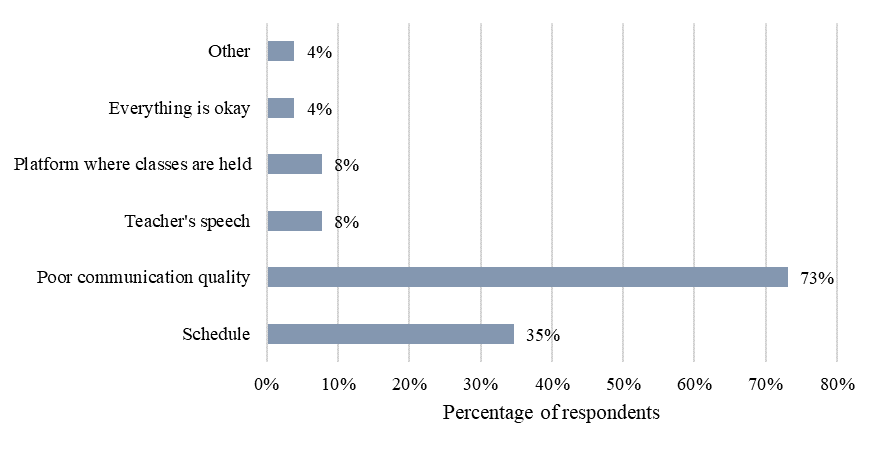
Evaluation of distance learning methods
In online classes, students most often lacked visibility – photos, videos, audio (54%) and dynamism (35%) (Figure
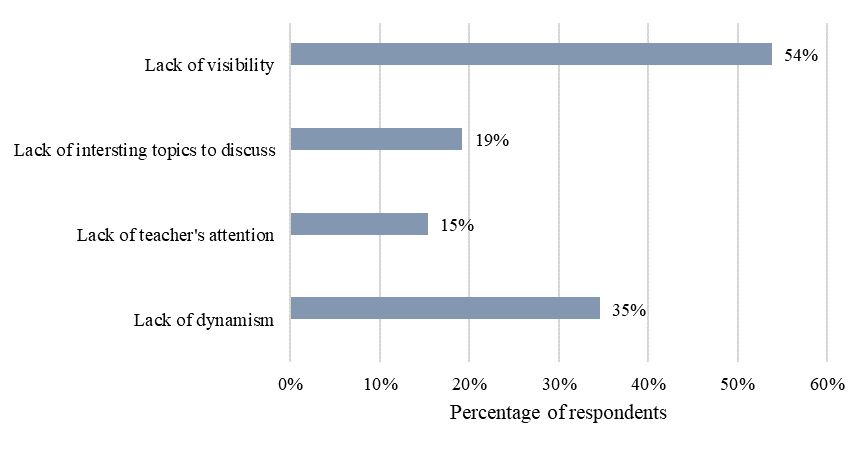
When evaluating interesting moments in distance learning Russian as a foreign language (Figure
Out of 26 respondents, one student chose only one activity that was interesting for them, and two indicated all types of activity. Approximately an equal number of respondents (42% and 38% respectively) identified 2 and 3 interesting points in distance learning. Thus, the teacher can vary methods and ways to attract students’ attention and maintain their interest in distance learning.
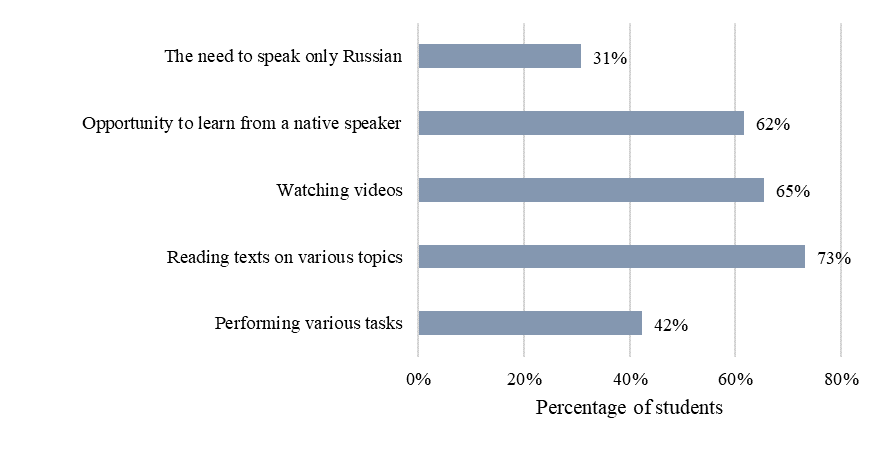
Students have identified ways of presenting information that allow them to easily remember educational material in online Russian as a foreign language classes. This is presentation of information in the form of a Power Point presentation (42%) and teacher’s explanations, accompanied by visualization of the material (23%). The remaining 35% of responses are less significant factors (Figure
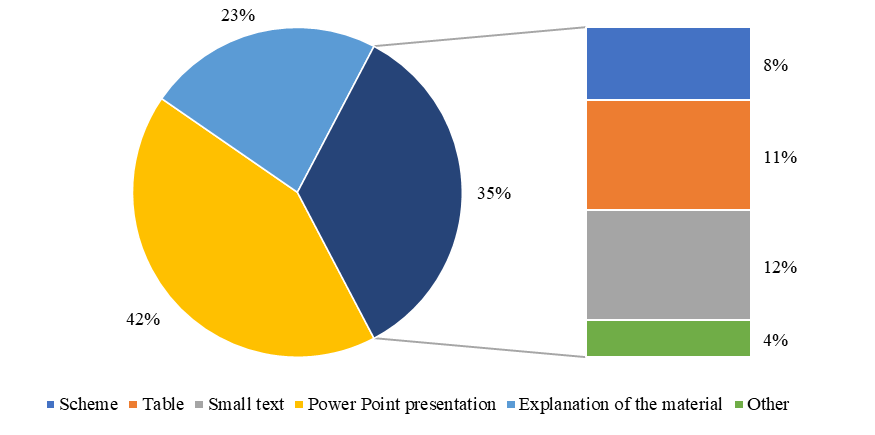
When asked about the forms of knowledge control, more than half of the students (54%) said that they are comfortable with performing tests in the form of a test with the choice of the correct answer from several (Figure
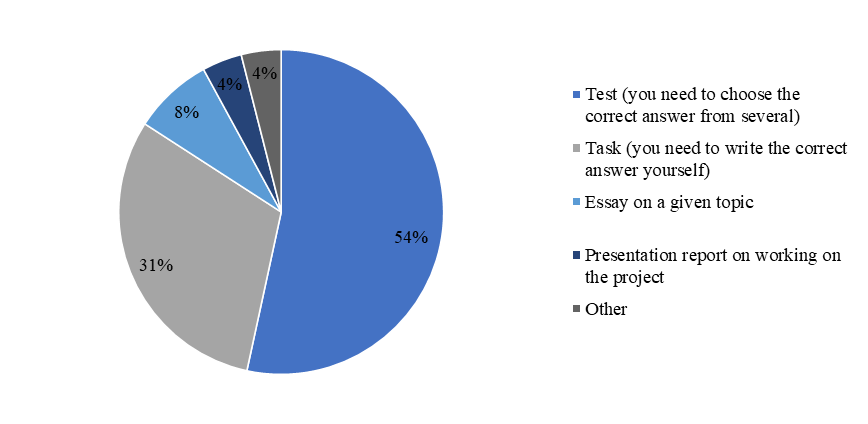
According to them, students most often experienced a subjective sense of satisfaction after a distance lesson (Figure
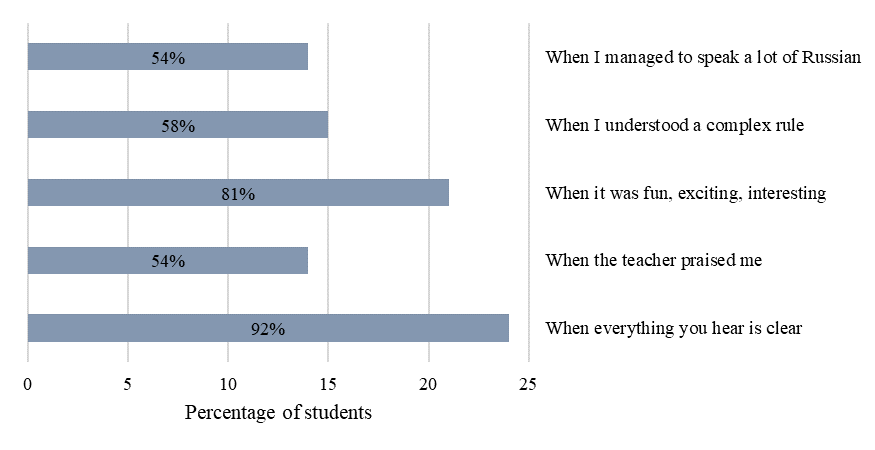
As wishes, students wrote that they would like to get more knowledge about Russia on topics that were not included in the textbook. In addition, students expect interesting videos and explanations in the classroom. Qualitative analysis of responses showed that it is important for students to provide materials in text form (including new words). Only two of the respondents (7.7%) wanted to return to University, and 61.5% of students did not express any special wishes.
Two respondents wrote that the class time was reduced. Taking into consideration that the time of classes did not change, including when changing to the distance form, such comments may indicate a high interest of students when "time runs unnoticed". All this indicates that students are satisfied with distance learning.
One respondent expressed a desire to reduce the time of classes due to the fact that students are tired. Such a wish may indicate a high psychological load during a distance lesson, associated with an unusual format of communication with the teacher and fellow students, and further study of the issue is required. One student's wish to increase self-awareness was notable, because "when we are engaged in remote training, maybe someone is in touch, but the sound is turned off, and they do what they want to do." This confirms relevance of increasing students’ interest in distance learning.
Thus, we can conclude that the hypothesis was confirmed. The proposed questions and answers to them reflect the attitude of foreign language students to FL distance learning in Russia and give reason for teachers to think about changing the method of conducting distance learning.
Conclusion
Of all the variety of ways to organize FL distance learning, the most popular in Russia in the conditions of mass transition has become a video conference. The method of giving practical classes online differs from the traditional form.
When starting to develop the content of a video conference, the teacher of Russian as a foreign language can be offered the following:
- prepare the main materials used in the lesson and additional materials (for self-study), taking into account students’ needs and interests, such as photos, videos, podcasts, texts, web links, etc.;
- convert all prepared text materials into electronic form (including printed versions of textbooks) and place them in special storage facilities;
- to maintain interest and ensure the dynamics of the process, regularly alternate activities (listening, speaking, writing, reading), use presentations, video clips, texts, tasks, podcasts, photos and illustrations.
- think about ways to fix explanations (writing in the form of texts or diagrams) and save the training information of the lesson (transcript and video recording of the lesson);
- plan the use of various technical features to activate speech (for example, separate channels in Microsoft Teams for working in pairs; mobile voice recorders for practicing reading skills and correct pronunciation).
References
- Blagonravova, M. A., Muratova, O. A., & Trostina, K. V. (2016). Specifika raboty` prepodavatelya pri distancionnom obuchenii inostrannomu yazy`ku v neyazy`kovom vuze [The specifics of a teacher's work in distance learning of a foreign language in a non-linguistic University]. Psihologiya i pedagogika: metodika i problemy prakticheskogo primeneniya, 53, 82-93.
- Bondarenko, T., & Kolmakov, V. (2018). Distancionnoe obuchenie kak aktivnaya obrazovatel`naya texnologiya: ocenka celesoobraznosti vnedreniya [Distance education as an active educational technology: rationale for implementation]. Azimuth of scientific research: pedagogy and psychology, 7, 3(24), 53-57.
- Gerasimova, S. A., & Makarova, I. V. (2016). Iz opy`ta ispol`zovaniya programmny`x produktov iSPRING dlya prepodavaniya russkogo yazy`ka kak inostrannogo [From the experience of use of software products iSPRING for teaching Russian language as a foreign language]. Chelovek v informatsionnom prostranstve, Sbornik nauchnyh trudov, 88-94.
- Doughty, C. J., & Long, M. H. (2003). Optimal psycholinguistic environments for distance foreign language learning. Language Learning & Technology, 7(3), 50-80. Retrieved from https://scholarspace.manoa.hawaii.edu/bitstream/10125/25214/1/07_03_doughty.pdf
- Coggins, C. C. (1988). Preferred learning styles and their impact on completion of external degree programs. The American Journal of Distance Education, 2(1), 25–37.
- Dmitriev, M. E., Dmitrieva, L. M., & Serezhkina, A. E. (2016). Otnoshenie k distancionnomu obrazovaniyu v pedagogicheskoj srede vuza [Attitude to distance education in the pedagogical environment of the University]. Nauchnyj al'manah, 8-1(22), 113-116.
- Ibanez, M., Delgado Kloos, C., Leony, D., Garcia Rueda, J. J., & Maroto, D. (2011). Learning a Foreign Language in a Mixed-Reality Environment. IEEE Internet Computing Magazine, 15(6), 44–47. https://doi.org/10.1109/MIC.2011.78
- Mileyko, E. V. (2015). Primenenie informacionny`x texnologij v distancionnom obuchenii russkomu yazy`ku inostranny`x studentov [The application of information technology in distance learning the russian language for foreign students]. Nauchnye trudy KubGTU, 3, 16-25.
- Moore, J. L., Dickson-Deane, C., & Galyen, K. (2011). E-Learning, online learning, and distance learning environments: Are they the same? The Internet and Higher Education, 14(2), 129–135. https://doi.org/10.1016/j.iheduc.2010.10.001
- Rehn, N., Maor, D., & McConney, A. (2016). Investigating teacher presence in courses using synchronous videoconferencing. Distance Education, 37(3), 302-316. https://doi.org/10.1080/01587919.2016.1232157
- Simpson, O. (2018). Supporting Students in Online, Open and Distance Learning. Open and Flexible Learning Series. Routledge.
- Simonson, M., Zvacek, S. M., & Smaldino, S. (2019). Teaching and Learning at a Distance: Foundations of Distance Education (7th Edition). IAP.
- Sime, J-A., & Themelis, C. (2020). Educators’ perspectives on transmedia identity management: Redefining tele-teacher presence. Distance Education, 41(1). https://doi.org/10.1080/01587919.2020.1727292
- Tareva, E. G. (2015). Razvitie lingvoobrazovatel`ny`x praktik: optimistichnaya proekciya [Evolution of foreign language teaching practices: optimistic projection]. Vestnik Moskovskogo gorodskogo pedagogicheskogo universiteta. Seriya: Filologiya. Teoriya yazyka. Yazykovoe obrazovanie, 2(18), 75-85.
- Uskova, G. A. (2005). Pedagogicheskie usloviya razvitiya tvorcheskogo potenciala uchashhixsya nachal`ny`x klassov v shkole polnogo dnya [Pedagogical conditions for the development of creative potential of primary school students in full-time schools]. [Doctoral Dissertation]. Retrieved April 23, 2020, from https://dlib.rsl.ru/01003299145
- Weindorff-Sysoeva, М. Е. (2018). Metodika distancionnogo obucheniya: uchebnoe posobie dlya vuzov [Distance learning methods: textbook for universities]. Urait.
- Zawacki-Richter, O., & Naidu, S. (2016). Distance Education. Mapping research trends from 35 years of publications in Distance Education. Distance Education, 37(3), 245-269. https://doi.org/10.1080/01587919.2016.1185079
Copyright information

This work is licensed under a Creative Commons Attribution-NonCommercial-NoDerivatives 4.0 International License.
About this article
Publication Date
20 November 2020
Article Doi
eBook ISBN
978-1-80296-094-5
Publisher
European Publisher
Volume
95
Print ISBN (optional)
-
Edition Number
1st Edition
Pages
1-1241
Subjects
Sociolinguistics, discourse analysis, bilingualism, multilingualism
Cite this article as:
Dugina, G. A. (2020). Approaches To Foreign Languages Distance Learning: How To Establish Dialogue Of Cultures. In Е. Tareva, & T. N. Bokova (Eds.), Dialogue of Cultures - Culture of Dialogue: from Conflicting to Understanding, vol 95. European Proceedings of Social and Behavioural Sciences (pp. 236-248). European Publisher. https://doi.org/10.15405/epsbs.2020.11.03.26

